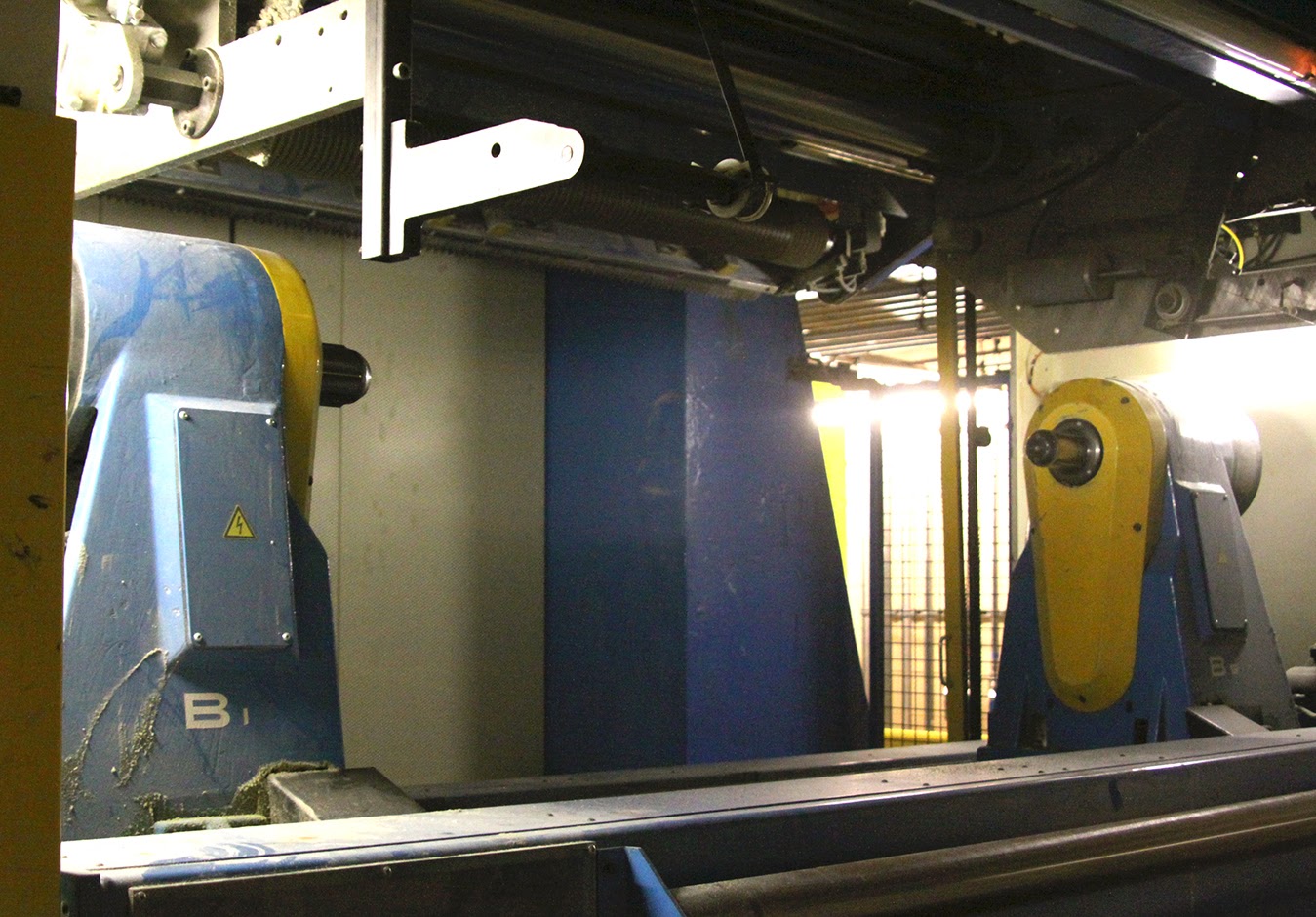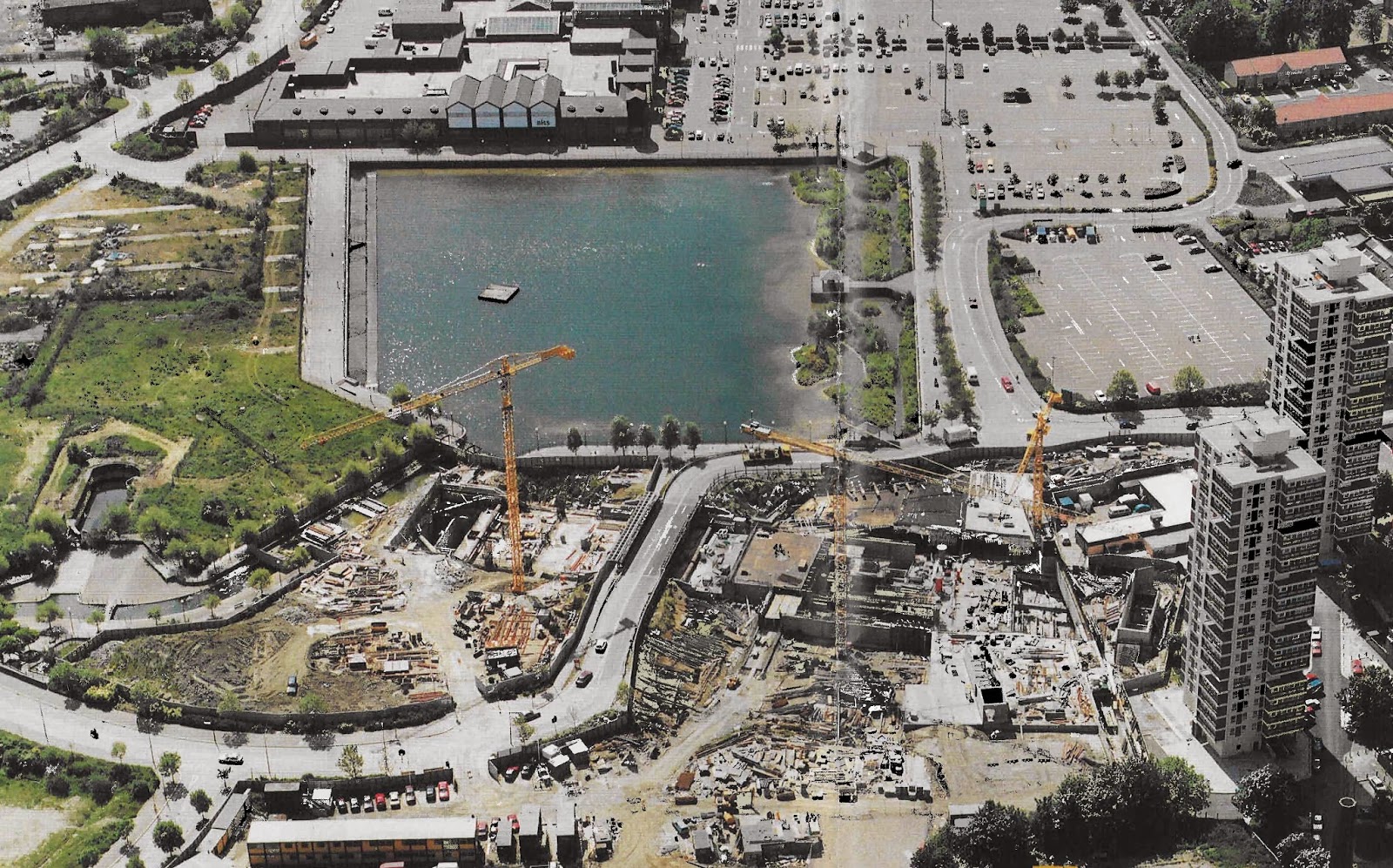 |
| Harmsworth Quays |
Harmsworth Quays was closed down by its owners, the Daily Mail and General Trust (DMGT), when they moved their operations to Thurrock (Essex), but the building remained, a big green local landmark, something of a blot on the landscape, but one that predates most of the residential development in Rotherhithe. When it opened it was a state of the art printing works.
Harmswoth Quays was built in 1989 and the site covers 12 acres. Now bereft of personnel, furniture and most of its machinery, it has become a rather marvelous piece of industrial archaeology. Its fate is, of course, inevitable. The Daily Mail sold the leasehold on the land to British Land (Southwark Council own the freehold) and they are planning to develop it for more building projects, the precise nature of which has yet to be nailed down. I will be talking more about the future of the site in later posts.
For anyone who has been reading my earlier posts about the development of the docks in Rotherhithe, Harmsworth Quays sits on what used to be Centre Pond, one of the timber ponds established by the Grand Surrey Dock and Canal Company when they established Albion Dock and a number of other timber ponds, all up and running by 1862. For more information
see my earlier post about the development of this area of Rotherhithe's docks and ponds.

British Land, who now own the property (and own Surrey Quays Shopping Centre), arranged for guided tours of the former works today, which was a really super opportunity for anyone interested in local history. I was booked into the 2pm tour, and thundered back from Gloucester this morning along the M4 to be on time to get there, camera in hand, to pick up my name badge and read the information boards. The boards were full of useful information (about which more in future posts) and there were a lot of people there reading them. Representatives from the Southwark-based urban planning practice Allies and Morrison were there to chat to visitors, and did a good job of answering questions and explaining how various different local development projects fit together under Southwark Council's general planning umbrella.
 |
| Paper racks |
From there, we were taken in groups around the print works. Utterly fascinating, and thanks to Larry our guide (who was an engineer there when it was all up and running) for taking us around. You can click on any of the photographs to see the bigger version.
The walk through the building from the meeting room to the first area on the itinerary made me very glad for the recommendation in the joining instructions for sensible shoes - much of the elevated walkways were open metal grids, and flat shoes were a must. We wended our way through various corridors and tall machine rooms until we reached a vast cavernous cathedral of metalwork soaring up and plunging down from where we stood. This eerily silent extravaganza of industrial excellence and abstract art was the place where the paper was received in 1.6 ton rolls, 336 per day. The crazy metal structure was a seemingly endless system of racks onto which the the paper was lifted by an automated mechanism. Apparently a James Bond movie was filmed there, Tomorrow Never Dies. It was so thoroughly magnificent that it was quite difficult to be dragged away, and a lot of people stood on the raised walkway staring out into the surrealistic chiaroscuro.
 |
| Print room, with printers at the far end |
From there we followed our guide to the printing machines themselves, again walking through long corridors which were once thundering away with machinery and personnel. The printing presses are quite simply impossible to describe. I have no idea what I thought they would be like, but I think I was imagining something the size of a small room, and not the vision before me, which consisted of machinery that reaches up to the ceiling three storeys away. Some of the printers were removed when the Daily Mail left, and others were purloined for their parts, but some remain complete and will have to be dismantled before the building is pulled down. The scale of the thing was simply staggering.

Next on the tour was the room in which all those infuriating inserts, advertising brochures, scratch cards, and promises of eternal happiness were added to the newspapers. Now a vast void with huge red caterpillars running along the ceilings this was apparently once stuffed full of bodies hard at work in a windowless warehouse-sized room. The red caterpillars were used for providing fresh air, and heaters were built into the ceiling. Everywhere we went in Harmsworth Quays it was important to keep looking up because the network of pipes and cables, air vents and funnels were tremendous. It becomes so obvious why the Pompidou Centre in Paris put their internal workings on the outside.
 |
| Set for Chasing Shadows |
Before making our way to the final leg of the tour, we passed through part of the building that is being used as a television set for a new police series called
Chasing Shadows. It has been set up as a set of offices, both open plan and private, which acts as the operational base of a special unit dedicated to tracking down serial killers who prey on vulnerable people. You can see a
write up of it on the ITV website. The photo on the left shows part of the set, with a police coat hanging on a hook and general chaos all around. The sheer level of office chaos was actually quite impressive - I've never worked in one quite that bad! Earlier on, where the printing machinery is located, another set consisting of some battered armchairs and a lot of graffiti (shown at the very end of this post) formed another part of the TV location, and it was so odd to see it all sitting there alongside the vast industrial hardware.
 |
| Loading bay |
We made our way to another warehouse-sized room in which the newspapers, the Daily Mail, the Evening Standard and Metro, were loaded onto lorries. Like any distribution hub, one wall consisted of a series of shuttered exits to which the lorries backed up for loading. The Evening Standard alone shipped 600,000 issues a day from that room. There was a huge digital display, which was happily feeding completely random symbols into the room. Heaven knows what information it once showed.
The building is extraordinary. I spent a lot of time a decade or so ago visiting freight hubs, and these were always fairly relentless in terms of functionality taking priority over any alleviating flourishes, but Harmsworth Quays takes that to new levels, with acres of open-mesh metal walkway and staircases, tiny corridors between machines, and vast ceilings that are an incredible maze of heaven-knows-what. The floor space, now clear, is simply endless, and the sense of emptiness and lifelessness quite extraordinary and somewhat eerie. There is always a certain sort of desolation about an abandoned building, but this one was particularly strange because it was still full of light and so very clean!
As I hammered down the M4 today I kept clock-watching and I am so glad that I got there on time. Thanks again to the organizers. I enjoyed it enormously.
The following are a random set of other photographs that I took today.
 |
Office door with a smiley face fingered into
the dust on the glass. It so made me smile. |
 |
| Printer - a bit bigger than my Canon desktop job! |
 |
| Ceiling |
 |
| Paper racks |
 |
| Print works room |
 |
| Printing presses |
 |
| Chasing Shadows set |







